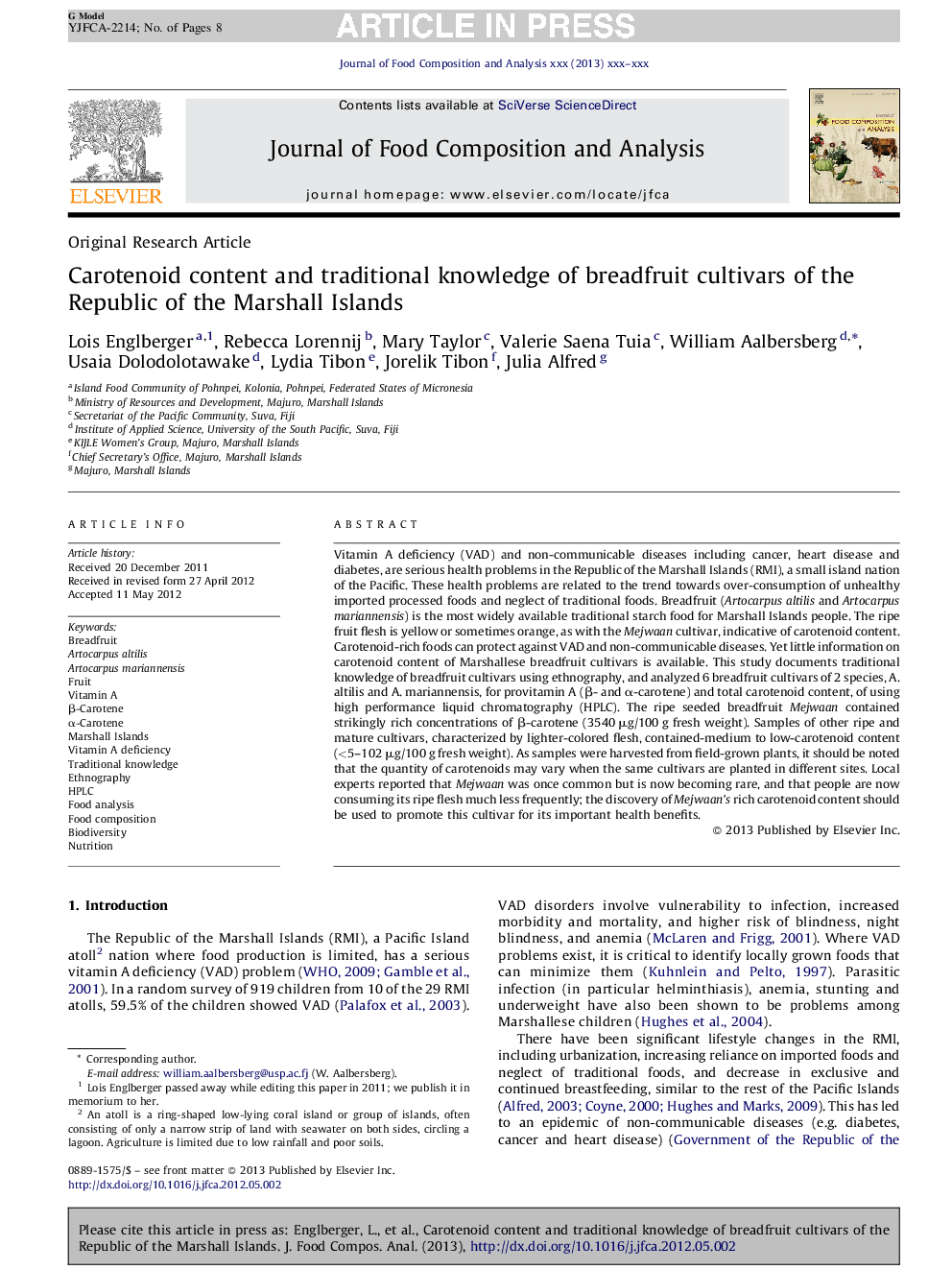| کد مقاله | کد نشریه | سال انتشار | مقاله انگلیسی | نسخه تمام متن |
|---|---|---|---|---|
| 10552732 | 967589 | 2014 | 8 صفحه PDF | دانلود رایگان |
عنوان انگلیسی مقاله ISI
Carotenoid content and traditional knowledge of breadfruit cultivars of the Republic of the Marshall Islands
ترجمه فارسی عنوان
محتوای کاروتنوئید و دانش سنتی ارقام نانوافصل جزایر مارشال
دانلود مقاله + سفارش ترجمه
دانلود مقاله ISI انگلیسی
رایگان برای ایرانیان
کلمات کلیدی
Artocarpus altilisα-Carotene - α-کاروتنβ-carotene - β-کاروتنBreadfruit - بدمرفرتFood analysis - تجزیه و تحلیل مواد غذاییFood composition - ترکیب مواد غذاییBiodiversity and nutrition - تنوع زیستی و تغذیهMarshall Islands - جزایر مارشالTraditional knowledge - دانش سنتیIndigenous foods - غذاهای بومیEthnography - مردم نگاری، اتنوگرافیFruit - میوهVitamin A - ویتامینAHPLC - کروماتوگرافی مایعی کاراVitamin A deficiency - کمبود ویتامین A
موضوعات مرتبط
مهندسی و علوم پایه
شیمی
شیمی آنالیزی یا شیمی تجزیه
چکیده انگلیسی
Vitamin A deficiency (VAD) and non-communicable diseases including cancer, heart disease and diabetes are serious health problems in the Republic of the Marshall Islands (RMI), a small island nation of the Pacific. These health problems are related to the trend towards over-consumption of unhealthy imported processed foods and neglect of traditional foods. Breadfruit (Artocarpus altilis and Artocarpus mariannensis) is the most widely available traditional starch food for RMI people. The ripe fruit flesh is yellow or sometimes orange, as with the Mejwaan cultivar, indicative of carotenoid content. Carotenoid-rich foods can protect against VAD and non-communicable diseases. Yet little information on carotenoid content of Marshallese breadfruit cultivars is available. This study documents traditional knowledge of breadfruit cultivars using ethnography, and analyzed 6 breadfruit cultivars of 2 species, A. altilis and A. mariannensis, for provitamin A (β- and α-carotene) and total carotenoid content, using high performance liquid chromatography (HPLC). The ripe seeded breadfruit Mejwaan contained strikingly rich concentrations of β-carotene (3540 μg/100 g fresh weight). Samples of other ripe and mature cultivars, characterized by lighter-colored flesh, contained medium- to low-carotenoid content (<5-102 μg/100 g fresh weight). As samples were harvested from field-grown plants, it should be noted that the quantity of carotenoids may vary when the same cultivars are planted in different sites. Local experts reported that Mejwaan was once common but is now becoming rare, and that people are now consuming its ripe flesh much less frequently; the discovery of Mejwaan's rich carotenoid content should be used to promote this cultivar for its important health benefits.
ناشر
Database: Elsevier - ScienceDirect (ساینس دایرکت)
Journal: Journal of Food Composition and Analysis - Volume 34, Issue 2, June 2014, Pages 192-199
Journal: Journal of Food Composition and Analysis - Volume 34, Issue 2, June 2014, Pages 192-199
نویسندگان
Lois Englberger, Rebecca Lorennij, Mary Taylor, Valerie Saena Tuia, William Aalbersberg, Usaia Dolodolotawake, Lydia Tibon, Jorelik Tibon, Julia Alfred,
